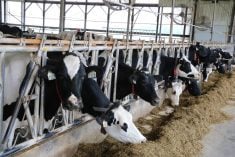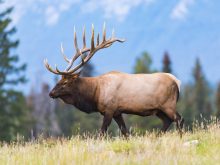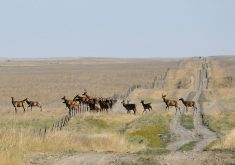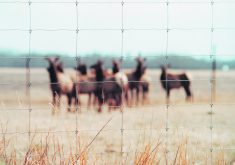Producers want to control feed supply damage by being allowed to hunt the animals on their own land
Elk are majestic animals that provide food for Indigenous communities and hunters, but the rising population is causing conflicts with Saskatchewan farmers.
The Saskatchewan Association of Rural Municipalities passed a resolution last year calling on the government to increase hunting licences where conflicts exist between farmers and ranchers and elk.
The resolution noted not all wildlife damage caused by elk is covered by the Saskatchewan Crop Insurance Corp. and large herds have the potential to spread chronic wasting disease and parasites such as liver flukes to other wildlife and livestock.
Read Also

Huge Black Sea flax crop to provide stiff competition
Russia and Kazakhstan harvested huge flax crops and will be providing stiff competition in China and the EU.
Ray Orb, SARM president, said discussions have been taking place but he described those meetings as coming in fits and starts with officials at the environment ministry and with Premier Scott Moe.
“The premier promised at our (March) convention that we would get depredation tags,” he said, referring to the hunting tags that allow landowners to take animals on their own land.
In subsequent meetings with Saskatchewan Environment Minister Dana Skoropad, Orb said they discussed the mechanics of how those tags could be issued. But Orb added since then, the issue has moved to the back burner.
He said SARM has met with the Saskatchewan stockgrowers and cattlemen’s associations in an effort to put forward a united message.
At their last collective meeting, Orb said Saskatchewan Party MLAs were in attendance.
“They’re hearing from their constituents from different parts of the province that there are some big problems as well.”
Orb said elk, along with deer and moose, have been raiding haystacks and grain bags in larger numbers the past few years as forage has been scarce.
“It was a really bad problem last winter because it was a perfect storm. We had a lot of snow early and it put pressure on the wildlife population because they couldn’t get through that snow and ice to get to feed,” he said.
Orb said he’s hoping a reinvigorated provincial wildlife advisory committee will be part of a collaborative solution.
“They haven’t met for a few years so it’s been kind of put on the back burner,” he said, but added he hopes a renewed push through that committee can initiate the process of getting depredation tags for producers.
For Battleford-area farmer Percy Waterhouse, a solution can’t be found soon enough as the number of elk visiting his farm have increased to dozens from zero in a few years.
“When we grew up here, there was no elk at all,” he said. “But we’ve been battling these things for 15 to 20 years and I’m going to say 10 years ago we had a meeting; we had all the government guys out here and they were going to make changes…. They were going to do this and that but the herd has only gotten way bigger.”
Waterhouse said he’s recruited some Indigenous groups to help hunt the elk but the elk population continues to increase.
“They love the canola fields and that’s predominately what they live on during the summer,” he said, adding his neighbour’s corn field was wiped out by grazing elk.
Waterhouse said it is especially difficult to process claims through crop insurance. He said there have been discrepancies in yield rates and the appeal system is unwieldy.
“If you see the damage that these (elk) did on the canola fields and you relate it to the compensation that we’re getting, it’s absolutely ridiculous.”
The Producer requested comment from SCIC but hadn’t received a response as of press time for this issue.
Conflicts between elk and producers have also been a problem in Alberta after a herd was reintroduced to CFB Suffield in the province’s southeast corner.
Those conflicts have been quelled in recent years after military officials allowed hunting of several thousand elk on the base and the province increased hunting tags in wildlife management units surrounding CFB Suffield.


















